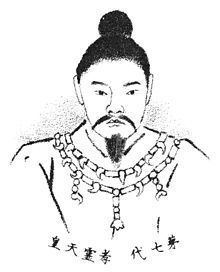Predecessor Kōan Parents Emperor Kōan | Died 215 BC Children Emperor Kōgen Successor Emperor Kōgen | |
 | ||
Reign 19 February 290 BC – 27 March 215 BC (traditional) Burial Kataoka no Umasaka no misasagi (Nara) Similar | ||
Emperor Kōrei (孝霊天皇, Kōrei-tennō); also known as Ooyamatonekohikofutoni no Mikoto; was the seventh emperor of Japan, according to the traditional order of succession.
Contents
No firm dates can be assigned to this emperor's life or reign, who is conventionally considered to have reigned from 290 BC to 215 BC, but he may have lived in the early 1st century.
Legendary narrative
Modern scholars have come to question the existence of at least the first nine emperors; Kōrei's descendant, Emperor Sujin is the first that many agree might have actually existed. The name Kōrei-tennō was assigned to him posthumously by later generations.
Kōrei is regarded by historians as a "legendary emperor" and there is a paucity of information about him. There is insufficient material available for further verification and study. The reign of Emperor Kinmei (c. 509 – 571 AD), the 29th emperor, is the first for which contemporary historiography is able to assign verifiable dates; However, the conventionally accepted names and dates of the early emperors were not to be confirmed as "traditional" until the reign of Emperor Kanmu (737–806), the 50th sovereign of the Yamato dynasty.
In the Kojiki and Nihon Shoki only his name and genealogy were recorded. He is believed to be son of Emperor Kōan; and his mother is believed to have been Oshihime, who was the daughter of Ametarashihiko-Kunio-shihito-no-mikoto. The Japanese have traditionally accepted this sovereign's historical existence, and an Imperial misasagi or tomb for Kōrei is currently maintained; however, no extant contemporary records have been discovered that confirm a view that this historical figure actually reigned. He was the sixth of eight emperors without specific legends associated with them, also known as the "eight undocumented monarchs" (欠史八代,, Kesshi-hachidai).
The Kojiki notes that it was during Kōrei's reign that Kibi was conquered.
Jien records that Kōrei was the eldest son of Emperor Kōan, and that he ruled from the palace of Ihoto-no-miya at Kuroda in what would come to be known as Yamato Province.
Kōrei is a posthumous name. It is undisputed that this identification is Chinese in form and Buddhist in implication, which suggests that the name must have been regularized centuries after the lifetime ascribed to Kōrei, possibly during the time in which legends about the origins of the Yamato dynasty were compiled as the chronicles known today as the Kojiki.
The actual site of Kōrei's grave is not known. This emperor is traditionally venerated at a memorial Shinto shrine (misasagi) in Nara.
The Imperial Household Agency designates this location as Kōrei's mausoleum. It is formally named Kataoka no Umasaka no misasagi.
Consorts and Children
Empress: kuwashihime (細媛命), daughter of shiki no Agatanushi Oome (磯城県主大目)
Kasuga no Chichihayamawakahime (春日之千千速真若比売)
Yamato no Kunikahime (倭国香媛), daughter of Wachitsumi (和知都美命)
Haeirodo (絙某弟), younger sister of Yamato no Kunikahime
